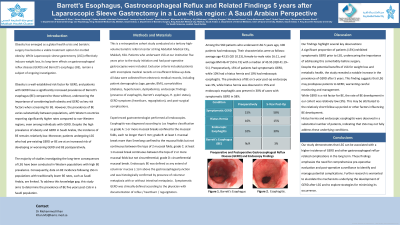Sunday Poster Session
Category: Esophagus
P0475 - Barrett’s Esophagus, Gastroesophageal Reflux, and Related Findings 5-Years After Laparoscopic Sleeve Gastrectomy in a Low-Risk Region: A Saudi Arabian Perspective
Sunday, October 27, 2024
3:30 PM - 7:00 PM ET
Location: Exhibit Hall E

Has Audio

Mohammed Khan, MBBS, MD
King Abdullah Medical City
Makkah, Makkah, Saudi Arabia
Presenting Author(s)
Mohammed Khan, MBBS, MD, Adnan Alzanbagi, MBBS, MD, Salem Alotaibi, MBBS, MD, Abdulaziz Tashkhandi, MBBS, MD, Laeeque Qurashi, MBBS, MD, Saad Alzahrani, MBBS, MD, Mahmoud Eliouny, MBBS, MD, Aly ElBahrawy, MBBS, MD, AlWahhaj Khogeer, MBBS, MD, Mohammed Hazazi, , Feras Fatani, , Suhail Hezry, , Mohammed Shariff, MBBS, MD
King Abdullah Medical City, Makkah, Makkah, Saudi Arabia
Introduction: Gastroesophageal reflux disease (GERD) is a common concern following laparoscopic sleeve gastrectomy (LSG). While studies from Western countries have reported a high incidence of Barrett’s esophagus (BE) long-term after LSG, limited data exist from the Saudi region. Our study aims to evaluate the extent of GERD-related findings, including BE, in patients 5 years post LSG.
Methods: We conducted a retrospective analysis at a tertiary high-volume bariatric referral center in the Kingdom of Saudi Arabia. Patients who underwent LSG were routinely assessed with pre- and post-operative gastroscopies. We assessed reflux symptoms and endoscopic findings in patients 5 years after LSG.
Results: < ![if !supportLists] >· < ![endif] >Among the 560 patients who underwent LSG 5 years ago, 108 patients had endoscopy. Their characteristics were as follows: average age 43.55 (SD 10.23), female-to-male ratio 16:11, and average BMI 46.47 (SD 6.73) with a median of 45.95 (IQR 41.19–51). Preoperatively, 15% of patients had symptomatic GERD, while 10% had a hiatus hernia and 10% had endoscopic esophagitis. The prevalence of BE on 5-year post-op endoscopy was 3%, while hiatus hernia was observed in 15% and endoscopic esophagitis was present in 30% of cases with symptomatic GERD in 58%.
Discussion: < ![if !supportLists] >· < ![endif] >Our study contributes valuable insights into GERD-related complications after LSG in a high-incidence obesity and low-incidence BE region. Although the observed 3% prevalence of BE 5 years post LSG is lower than what has been reported in Western studies, vigilance remains crucial, given that BE is a precursor to esophageal adenocarcinoma. Continued research will refine our understanding and guide evidence-based practices for patient care
Disclosures:
Mohammed Khan, MBBS, MD, Adnan Alzanbagi, MBBS, MD, Salem Alotaibi, MBBS, MD, Abdulaziz Tashkhandi, MBBS, MD, Laeeque Qurashi, MBBS, MD, Saad Alzahrani, MBBS, MD, Mahmoud Eliouny, MBBS, MD, Aly ElBahrawy, MBBS, MD, AlWahhaj Khogeer, MBBS, MD, Mohammed Hazazi, , Feras Fatani, , Suhail Hezry, , Mohammed Shariff, MBBS, MD. P0475 - Barrett’s Esophagus, Gastroesophageal Reflux, and Related Findings 5-Years After Laparoscopic Sleeve Gastrectomy in a Low-Risk Region: A Saudi Arabian Perspective, ACG 2024 Annual Scientific Meeting Abstracts. Philadelphia, PA: American College of Gastroenterology.
King Abdullah Medical City, Makkah, Makkah, Saudi Arabia
Introduction: Gastroesophageal reflux disease (GERD) is a common concern following laparoscopic sleeve gastrectomy (LSG). While studies from Western countries have reported a high incidence of Barrett’s esophagus (BE) long-term after LSG, limited data exist from the Saudi region. Our study aims to evaluate the extent of GERD-related findings, including BE, in patients 5 years post LSG.
Methods: We conducted a retrospective analysis at a tertiary high-volume bariatric referral center in the Kingdom of Saudi Arabia. Patients who underwent LSG were routinely assessed with pre- and post-operative gastroscopies. We assessed reflux symptoms and endoscopic findings in patients 5 years after LSG.
Results: < ![if !supportLists] >· < ![endif] >Among the 560 patients who underwent LSG 5 years ago, 108 patients had endoscopy. Their characteristics were as follows: average age 43.55 (SD 10.23), female-to-male ratio 16:11, and average BMI 46.47 (SD 6.73) with a median of 45.95 (IQR 41.19–51). Preoperatively, 15% of patients had symptomatic GERD, while 10% had a hiatus hernia and 10% had endoscopic esophagitis. The prevalence of BE on 5-year post-op endoscopy was 3%, while hiatus hernia was observed in 15% and endoscopic esophagitis was present in 30% of cases with symptomatic GERD in 58%.
Discussion: < ![if !supportLists] >· < ![endif] >Our study contributes valuable insights into GERD-related complications after LSG in a high-incidence obesity and low-incidence BE region. Although the observed 3% prevalence of BE 5 years post LSG is lower than what has been reported in Western studies, vigilance remains crucial, given that BE is a precursor to esophageal adenocarcinoma. Continued research will refine our understanding and guide evidence-based practices for patient care
Disclosures:
Mohammed Khan indicated no relevant financial relationships.
Adnan Alzanbagi indicated no relevant financial relationships.
Salem Alotaibi indicated no relevant financial relationships.
Abdulaziz Tashkhandi indicated no relevant financial relationships.
Laeeque Qurashi indicated no relevant financial relationships.
Saad Alzahrani indicated no relevant financial relationships.
Mahmoud Eliouny indicated no relevant financial relationships.
Aly ElBahrawy indicated no relevant financial relationships.
AlWahhaj Khogeer indicated no relevant financial relationships.
Mohammed Hazazi indicated no relevant financial relationships.
Feras Fatani indicated no relevant financial relationships.
Suhail Hezry indicated no relevant financial relationships.
Mohammed Shariff indicated no relevant financial relationships.
Mohammed Khan, MBBS, MD, Adnan Alzanbagi, MBBS, MD, Salem Alotaibi, MBBS, MD, Abdulaziz Tashkhandi, MBBS, MD, Laeeque Qurashi, MBBS, MD, Saad Alzahrani, MBBS, MD, Mahmoud Eliouny, MBBS, MD, Aly ElBahrawy, MBBS, MD, AlWahhaj Khogeer, MBBS, MD, Mohammed Hazazi, , Feras Fatani, , Suhail Hezry, , Mohammed Shariff, MBBS, MD. P0475 - Barrett’s Esophagus, Gastroesophageal Reflux, and Related Findings 5-Years After Laparoscopic Sleeve Gastrectomy in a Low-Risk Region: A Saudi Arabian Perspective, ACG 2024 Annual Scientific Meeting Abstracts. Philadelphia, PA: American College of Gastroenterology.
